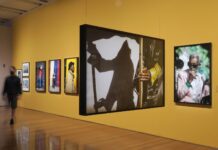Claudia Andujar – The Yanomami fight, shown at Instituto Moreira Salles (IMS), in São Paulo, has a manifest character. In about 300 images, the exhibition portrays the nearly 50 years of the artist’s commitment to indigenous people, at a time when the federal government encourages threats that endanger their condition in the Amazon.
Andujar has been recurrently seen in the last 20 years, from the so-called Biennial of Anthropophagy, in 1998, through Biennial How to live together, in 2006, having the pinnacle of visibility at the inauguration of its pavilion in Inhotim three years ago besides dozens of other shows, collective or individual, such as in the State Pinacoteca, in 2005, with The vulnerability of being.
However, the cutting proposed by Thyago Nogueira, who organizes the current show, gives strength to the work of Andujar, also presenting a vast material of notes, interviews for the press, books and even recorded journals, which attest to Andujar’s deep bond with the Yanomamis.
This is, in fact, the second show on Andujar at IMS. The first, In the Place of the Other, of 2015, exhibited at the Carioca headquarters, brought together the artist’s production in the 1960’s and 1970’s, especially as a photojournalist, but covering series that already pointed to her particular strategy of producing images from an effective involvement. The show even got the photos for the special edition of the magazine Reality, about the Amazon, of 1971. It was then his first contact with the Yanomami.
Three years later, in 1974, she returned equipped to remain a long time among those with whom she would live for more than four decades. “I think one of their most wonderful things is that they always seem to be happy. I hear them laughing in the morning, shouting joyfully, talking, singing. At night, when it gets dark, they lie on their nets and it’s the same thing for hours”, says the Brazilian naturalized Swiss, in one of the audios available at the show, held in 1974, one of hes first trips to Catrimani, the most visited people by her.
The present exposition is divided into two parts, and the first attests to this contagious joy of the Yanomami in the woods, in the maloca, in their rituals of celebration and in connection with the spirits of the forest. Some images are known, but there is a lot of new material. In general, they reinforce the intimate, affective, delicate relationship between the photographer and her portraits. They are close-up images of a witness who does not consider himself distant and who, to better convey what she sees, uses simple features, such as passing vaseline on the edges of the camera lens, to blur the surroundings, startling who is in the center of the image.
Still in this first room, as there are no walls dividing the space, but the photographs are hanging from the ceiling, there is almost a simulation of the coexistence of families in their huts. Undoubtedly it is an ethical option, of living together, which follows the respect that Andujar dedicates in the construction of images.
On the second floor, Nogueira highlights the militant character of Andujar, with the Marcados series, held in 1983, when with two doctors vaccinated hundreds of Yanomamis, protecting them against diseases that came along with the roads opened by the military dictatorship.
The highlight, however, is the installation of the Genocide of the Yanomami: Death of Brazil, created in 1989 and exhibited in the same year at the São Paulo Museum of Art (Masp) against the threat of demarcation of indigenous land by the Sarney government, in 19 “islands” in the Amazon, which would end by smothering them.
The creation of the Yanomami territory, an area twice the size of Belgium, would occur three years later in 1992 under the Collor government. For some theorists, because of Andujar’s commitment to the cause, this could be considered the greatest work of land art existing.











